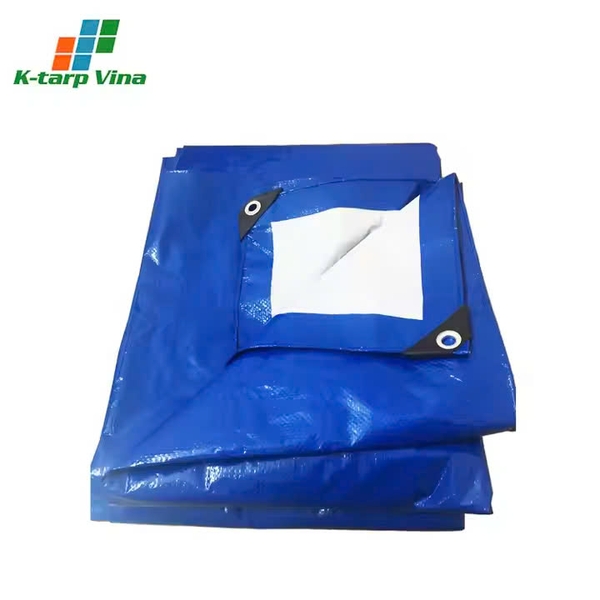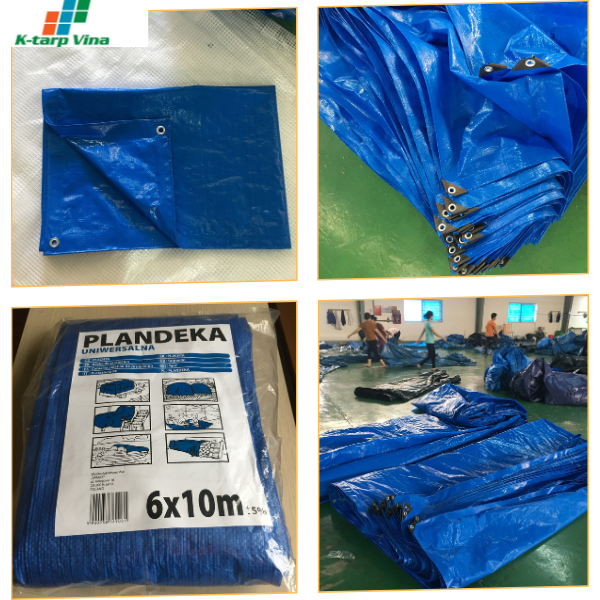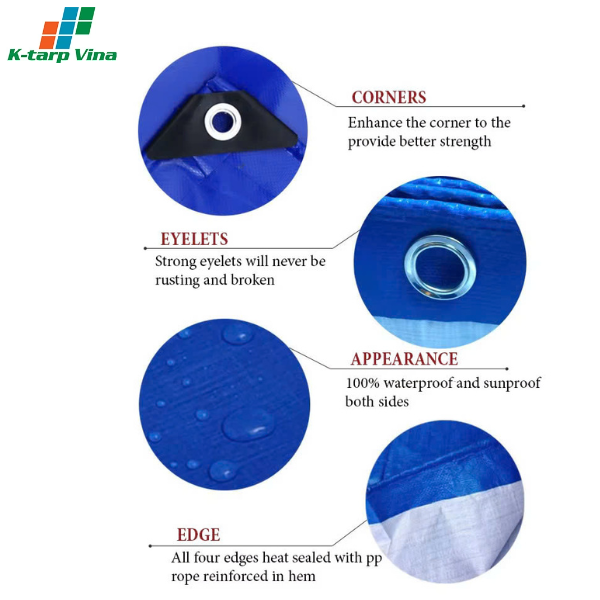Construction tarps are indispensable materials in construction projects, from small-scale to large-scale endeavors. Beyond protecting the site from adverse weather conditions, high-quality construction tarps ensure safety, reduce costs, and enhance construction efficiency. However, with the diverse range of models and quality levels available in the market, how can you select the most suitable product? In this article, Ktarp shares 5 important criteria for choosing high-quality construction tarps, empowering you to make informed and optimal decisions for your construction projects.
Why Use Construction Tarps?

In the construction industry, construction tarps play a vital role due to their numerous benefits. They shield projects from adverse weather conditions such as rain, sun, wind, or snow, preventing damage to materials like cement, wood, and steel while keeping the work area dry. Additionally, construction tarps enhance safety by preventing debris or materials from falling, protecting workers and passersby while reducing dust and noise that could impact the surrounding environment.
Moreover, they create stable working conditions for laborers, protect machinery and equipment, and ensure project progress even in harsh weather. Construction tarps also help control the work environment, such as regulating temperature or humidity for specific tasks or maintaining site cleanliness. Beyond functionality, they contribute to aesthetics by concealing the mess of construction sites, creating a professional appearance and complying with safety and environmental regulations in certain regions. Thanks to their cost-effectiveness and versatility, construction tarps are an essential solution in construction.
Key Benefits of Construction Tarps:
5 Essential Criteria for Choosing Construction Tarps

1. Material of Construction Tarps
The material is the most critical factor when selecting construction tarps, as it determines durability, protection capabilities, and suitability for specific projects. The market offers various tarp materials, each with distinct characteristics to meet different needs. Below is a detailed analysis of three common tarp materials: Polyethylene (PE), Polyvinyl Chloride (PVC), and Canvas.
Polyethylene (PE)
Polyethylene tarps, commonly known as PE plastic tarps, are popular due to their affordability and flexibility. Made from tightly woven synthetic plastic fibers, PE tarps are lightweight yet effective at waterproofing. They are often coated with a thin plastic layer to enhance UV resistance and abrasion resistance. These properties make PE tarps ideal for temporary projects or short-term coverage, such as protecting construction materials, shielding sites in early stages, or creating temporary shelters for workers. However, PE tarps have lower durability and are prone to tearing under strong forces or prolonged exposure to harsh weather like intense sun or heavy rain. Thus, they are less suitable for long-term projects or those requiring high durability.
Polyvinyl Chloride (PVC)
PVC tarps are a premium option, made from polyvinyl chloride combined with polyester mesh layers, offering superior durability and strength. These tarps provide near-absolute waterproofing, tear resistance, and the ability to withstand harsh weather conditions, including storms, extreme heat, or freezing temperatures. PVC tarps are often coated with UV-resistant, anti-mold, and chemical-resistant layers, extending their lifespan and maintaining performance over time. These qualities make PVC tarps ideal for long-term construction projects, such as covering entire sites, creating partitions for large work areas, or protecting equipment and materials in challenging environments. However, PVC tarps are more expensive than PE tarps, and their heavier weight may pose challenges during installation or transport without proper equipment.
Canvas
Canvas tarps, made from cotton or a cotton-polyester blend, stand out for their eco-friendliness and breathability. These tarps are often treated to enhance durability and moisture resistance, but their waterproofing is inferior to PE and PVC tarps. As a result, canvas tarps are not ideal for projects requiring absolute water protection but are well-suited for indoor applications or projects with low waterproofing needs, such as covering dry materials, protecting equipment in storage, or creating temporary workspaces. Canvas tarps are durable, resist wear over time, and offer a professional, aesthetic appearance. However, they are more expensive than PE tarps and require regular maintenance to prevent mold if exposed to prolonged moisture.
2. Thickness and Weight
The thickness of construction tarps, typically measured in mils or GSM (grams per square meter), directly impacts durability and strength. Thicker tarps (e.g., 10 mils or above, or 200 GSM) are more durable, tear-resistant, and suitable for large projects or harsh weather conditions. Conversely, thinner tarps (below 10 mils or 100 GSM) are lighter and easier to handle but are best for temporary or light-duty coverage.
Weight is another key consideration. Heavier tarps provide greater stability but can be challenging to install, especially for projects requiring frequent repositioning. Lighter tarps, on the other hand, are more flexible and ideal for small-scale or short-term projects.
Tip for choosing tarps: Clearly define the purpose (e.g., rain protection, sun shielding, dust control) and consult with contractors to select the appropriate thickness and weight. Always verify the actual thickness upon delivery to avoid receiving substandard products.
See also: Discover durable quality medium duty tarps in Vietnam
3. Size and Customization

The size of construction tarps must match the project’s coverage area to ensure comprehensive protection. Standard tarp sizes, such as 3x4m, 4x6m, or 6x8m, are widely available. For unique projects, you can request custom-cut tarps from suppliers.
Additional features, such as metal grommets, tie-down ropes, or reinforced edges, are also crucial. Metal grommets facilitate secure fastening, especially in windy conditions, while reinforced edges enhance durability and prevent tearing.
Tip: Measure the coverage area carefully and include extra material for overlap to ensure full protection. For custom sizes, choose suppliers with professional cutting and sewing services to guarantee quality.
4. Weather Resistance and Durability
High-quality construction tarps must withstand harsh weather conditions, such as heavy rain, intense sunlight, or strong winds. Key factors to consider include:
5. Price and Reputable Brands

The price of construction tarps varies based on material, thickness, size, and brand. PE tarps are more affordable, ranging from 10,000-30,000 VND/m², while premium PVC tarps can cost 50,000-100,000 VND/m². Avoid overly cheap tarps, as poor quality may lead to quick damage, increasing repair costs.
Reputable brands ensure product quality and reliable after-sales service. Established brands provide clear product information, warranties, and robust customer support. Research user reviews or construction forums to identify trustworthy suppliers.
Tip: Compare prices from multiple suppliers and prioritize those with transparent return policies. Inspect products upon delivery to ensure they meet the promised quality.
Why Use Construction Tarps?

In the construction industry, construction tarps play a vital role due to their numerous benefits. They shield projects from adverse weather conditions such as rain, sun, wind, or snow, preventing damage to materials like cement, wood, and steel while keeping the work area dry. Additionally, construction tarps enhance safety by preventing debris or materials from falling, protecting workers and passersby while reducing dust and noise that could impact the surrounding environment.
Moreover, they create stable working conditions for laborers, protect machinery and equipment, and ensure project progress even in harsh weather. Construction tarps also help control the work environment, such as regulating temperature or humidity for specific tasks or maintaining site cleanliness. Beyond functionality, they contribute to aesthetics by concealing the mess of construction sites, creating a professional appearance and complying with safety and environmental regulations in certain regions. Thanks to their cost-effectiveness and versatility, construction tarps are an essential solution in construction.
Key Benefits of Construction Tarps:
- Protect projects from weather impacts (rain, sun, wind, snow).
- Prevent damage to construction materials like cement, wood, and steel.
- Keep the work area dry and stable.
- Ensure safety by preventing debris or materials from falling.
- Protect workers and passersby.
- Reduce dust and noise, safeguarding the surrounding environment.
5 Essential Criteria for Choosing Construction Tarps

1. Material of Construction Tarps
The material is the most critical factor when selecting construction tarps, as it determines durability, protection capabilities, and suitability for specific projects. The market offers various tarp materials, each with distinct characteristics to meet different needs. Below is a detailed analysis of three common tarp materials: Polyethylene (PE), Polyvinyl Chloride (PVC), and Canvas.
Polyethylene (PE)
Polyethylene tarps, commonly known as PE plastic tarps, are popular due to their affordability and flexibility. Made from tightly woven synthetic plastic fibers, PE tarps are lightweight yet effective at waterproofing. They are often coated with a thin plastic layer to enhance UV resistance and abrasion resistance. These properties make PE tarps ideal for temporary projects or short-term coverage, such as protecting construction materials, shielding sites in early stages, or creating temporary shelters for workers. However, PE tarps have lower durability and are prone to tearing under strong forces or prolonged exposure to harsh weather like intense sun or heavy rain. Thus, they are less suitable for long-term projects or those requiring high durability.
Polyvinyl Chloride (PVC)
PVC tarps are a premium option, made from polyvinyl chloride combined with polyester mesh layers, offering superior durability and strength. These tarps provide near-absolute waterproofing, tear resistance, and the ability to withstand harsh weather conditions, including storms, extreme heat, or freezing temperatures. PVC tarps are often coated with UV-resistant, anti-mold, and chemical-resistant layers, extending their lifespan and maintaining performance over time. These qualities make PVC tarps ideal for long-term construction projects, such as covering entire sites, creating partitions for large work areas, or protecting equipment and materials in challenging environments. However, PVC tarps are more expensive than PE tarps, and their heavier weight may pose challenges during installation or transport without proper equipment.
Canvas
Canvas tarps, made from cotton or a cotton-polyester blend, stand out for their eco-friendliness and breathability. These tarps are often treated to enhance durability and moisture resistance, but their waterproofing is inferior to PE and PVC tarps. As a result, canvas tarps are not ideal for projects requiring absolute water protection but are well-suited for indoor applications or projects with low waterproofing needs, such as covering dry materials, protecting equipment in storage, or creating temporary workspaces. Canvas tarps are durable, resist wear over time, and offer a professional, aesthetic appearance. However, they are more expensive than PE tarps and require regular maintenance to prevent mold if exposed to prolonged moisture.
2. Thickness and Weight
The thickness of construction tarps, typically measured in mils or GSM (grams per square meter), directly impacts durability and strength. Thicker tarps (e.g., 10 mils or above, or 200 GSM) are more durable, tear-resistant, and suitable for large projects or harsh weather conditions. Conversely, thinner tarps (below 10 mils or 100 GSM) are lighter and easier to handle but are best for temporary or light-duty coverage.
Weight is another key consideration. Heavier tarps provide greater stability but can be challenging to install, especially for projects requiring frequent repositioning. Lighter tarps, on the other hand, are more flexible and ideal for small-scale or short-term projects.
Tip for choosing tarps: Clearly define the purpose (e.g., rain protection, sun shielding, dust control) and consult with contractors to select the appropriate thickness and weight. Always verify the actual thickness upon delivery to avoid receiving substandard products.
See also: Discover durable quality medium duty tarps in Vietnam
3. Size and Customization

The size of construction tarps must match the project’s coverage area to ensure comprehensive protection. Standard tarp sizes, such as 3x4m, 4x6m, or 6x8m, are widely available. For unique projects, you can request custom-cut tarps from suppliers.
Additional features, such as metal grommets, tie-down ropes, or reinforced edges, are also crucial. Metal grommets facilitate secure fastening, especially in windy conditions, while reinforced edges enhance durability and prevent tearing.
Tip: Measure the coverage area carefully and include extra material for overlap to ensure full protection. For custom sizes, choose suppliers with professional cutting and sewing services to guarantee quality.
4. Weather Resistance and Durability
High-quality construction tarps must withstand harsh weather conditions, such as heavy rain, intense sunlight, or strong winds. Key factors to consider include:
- Waterproofing: Tarps should have a waterproof coating to protect the site during rainy seasons.
- UV Resistance: A UV-resistant coating prevents fading or tearing under prolonged sun exposure.
- Wind and Temperature Resistance: Tarps must be sturdy enough to resist tearing in strong winds or high temperatures.
5. Price and Reputable Brands

The price of construction tarps varies based on material, thickness, size, and brand. PE tarps are more affordable, ranging from 10,000-30,000 VND/m², while premium PVC tarps can cost 50,000-100,000 VND/m². Avoid overly cheap tarps, as poor quality may lead to quick damage, increasing repair costs.
Reputable brands ensure product quality and reliable after-sales service. Established brands provide clear product information, warranties, and robust customer support. Research user reviews or construction forums to identify trustworthy suppliers.
Tip: Compare prices from multiple suppliers and prioritize those with transparent return policies. Inspect products upon delivery to ensure they meet the promised quality.

 Vận hành bởi Trương Anh Vũ®
Vận hành bởi Trương Anh Vũ®